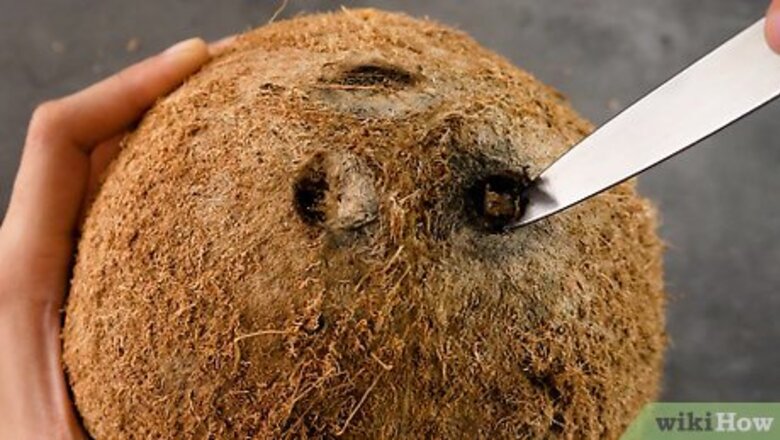
views
Eating Raw Coconut

Poke into the coconut with a sharp knife. Place the coconut on a cutting board with its holes or indentations facing up. Brace the bottom of the coconut firmly with one hand, or ground it by placing it on top of a rolled up dish cloth. With the other hand, try poking a sharp knife into each of the coconut's three holes until it goes in easily. Poke the knife into the coconut just enough to create an opening, then remove it carefully. A screwdriver can be used instead of a knife to poke into the coconut.
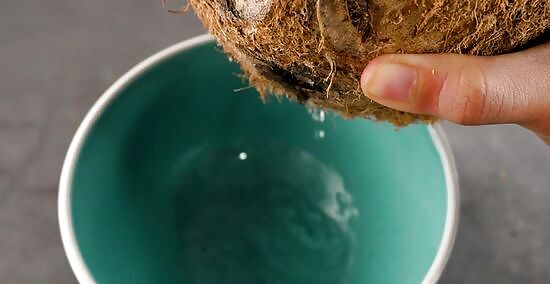
Drain the coconut water into a bowl or glass. Pick up the coconut and turn it upside down over a container. Allow it to drain it completely. Save the coconut water to drink or add to a smoothie later on.
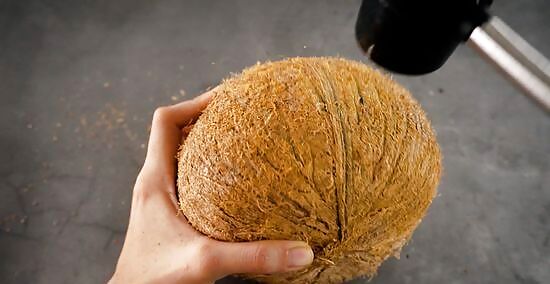
Place the coconut on a hard surface and break it up with a hammer. The outer shell of the coconut is so hard that a regular knife will not be able to cut through it. To break it, place the coconut in a clean plastic bag or large Ziploc bag and place it on a hard surface, like a concrete driveway. Use a hammer to smash the coconut until it breaks into pieces.
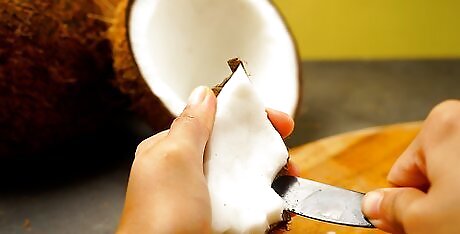
Use a butter knife to separate the coconut flesh from the shell. Remove the broken pieces of coconut from the plastic bag and place them back on the cutting board. Turn each piece face down and brace the shell with one hand. Approach the side of the upside down coconut with a butter knife and carefully pry away the flesh from the shell.
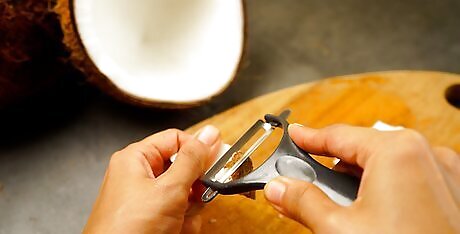
Peel off the skin from the coconut flesh with a vegetable peeler. Once all of the coconut flesh is freed from its shell, use a vegetable peeler to remove its skin. Pull off the brown fiber coating as you would a potato. Rinse the coconut flesh to remove any residue from the skin.
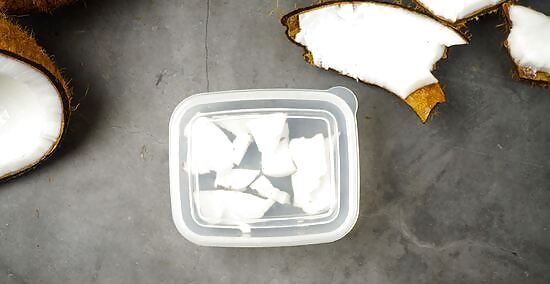
Store fresh coconut in the fridge for 4-5 days. Place the pieces of coconut in an airtight plastic container or sealed zip lock bag. Keep them refrigerated for 4-5 days.
Making Shredded Coconut
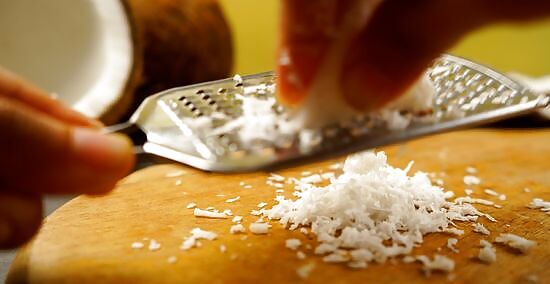
Grate coconut into small or large pieces. Grate fresh coconut with a metal cheese grater. Use the side with smaller holes for finely shredded coconut, and the side with larger holes for bigger coconut flakes. To make larger, chip-like pieces, use a vegetable peeler.
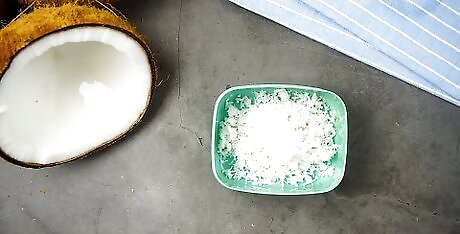
Keep grated coconut in the fridge for 1-2 days. If you grate coconut, store in in the fridge in an airtight plastic container. Try to use it within 2 days, when it will begin to go bad. Be sure to throw out any leftover grated coconut after this time.
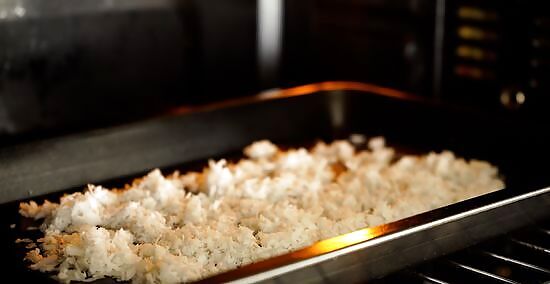
Toast coconut flakes in the oven for 5-10 minutes. Pre-heat the oven to 325 degrees Fahrenheit (approximately 167 degrees Celsius). Spread shredded coconut out on a non-stick baking sheet. Toast it for 5-10 minutes until it is browned. Use fresh coconut that you've grated, or purchased shredded coconut from your local grocery store. If you purchase sweetened coconut, they will need less cooking time to brown. Toasted coconut can be added to yogurt, salads, cereal, ice cream, and other snacks.

Store toasted coconut flakes in a cool, dry place for up to 2 months. Place toasted, shredded coconut in an airtight plastic container. Store the container in a spot that won't get warm or damp, like a kitchen cupboard. The coconut will keep for up to two months if it is sealed properly. Shredded coconut will keep in the freezer for up to a year.
Cooking with Coconut
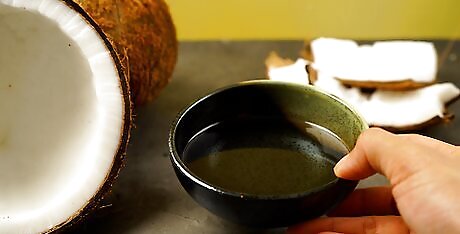
Cook with coconut oil. Coconut oil can be an excellent swap for olive oil in your regular recipes, particularly if you’re cooking a stir fry meal. While it contains just as much fat as other oils, coconut oil also contains medium chain fatty acids, which are metabolized faster in the body. Use the same amount of coconut oil in your recipes as your would other fats.

Add coconut milk to soups and sauces. Coconut milk is a vegan-friendly, dairy-free way to add a bit of creaminess to soups and sauces without making them too heavy. For instance, try making a pineapple coconut sauce for flavorful meals. Coconut milk can also make a great marinade for chicken or shrimp.

Cook coconut-centered meals. Coconut is a key ingredient in many popular dishes from around the world. Experiment with different recipes to get a feel for how to cook with coconut. Some dishes to try could include: Coconut chutney, a South Indian dish Thai curry Tom Kha Gai soup Coconut shrimp
Making Coconut Desserts
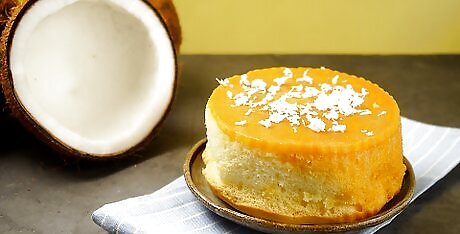
Bake a coconut cake. Preheat your oven to 325 °F (163 °C). In a large bowl, mix 1 can of sweetened condensed milk, 3 eggs, 0.5 cups (120 ml) coconut milk, 0.5 cups (120 ml) milk, and 2 cups (470 ml) grated coconut. Pour the mixture into a greased, medium-sized cake pan and bake for 25 minutes.
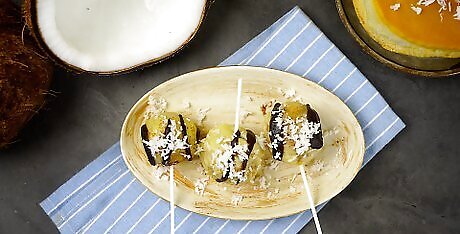
Make coconut cream cake pops. Make coconut cream cake pops by crumbling coconut cake in a bowl and stirring in vanilla frosting. Add frosting and stir until the mixture has a dough-like consistency. Roll the dough into ping pong-sized balls and chill them in the fridge for 2 hours, then insert lollipop sticks. For an added touch, dip the cake pops in melted chocolate and chill them for another 2 hours.
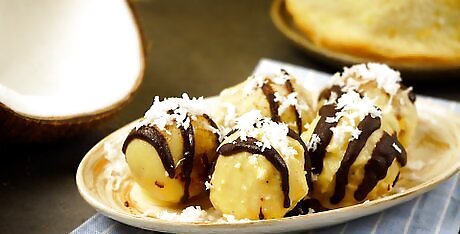
Make coconut candy. Make chocolate-covered coconut candy by mixing 1.75 cup shredded coconut, 1.75 cups confectioners' sugar, 1 cup chopped almonds, and 0.5 cups (120 ml) condensed milk in a medium-sized bowl. Roll the mixture into balls that are approximately 1 inch (2.5 cm) in size and chill them in the fridge for 20 minutes. Dip the balls in melted chocolate and let them cool for another 20 minutes.
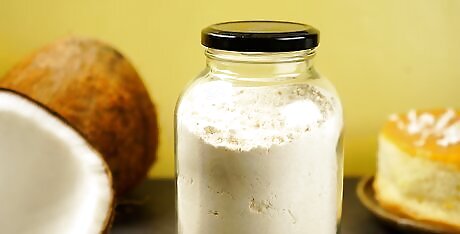
Replace grain-based flour with coconut flour for baking. Coconut flour is a protein-rich, gluten-free alternative to regular flour. While it can be used in place of regular flour, you should swap it in at only a third of the flour that your recipe calls for, as it is much more absorbent. Be sure to mix your ingredients very thoroughly to prevent the coconut flour from clumping.




















Comments
0 comment